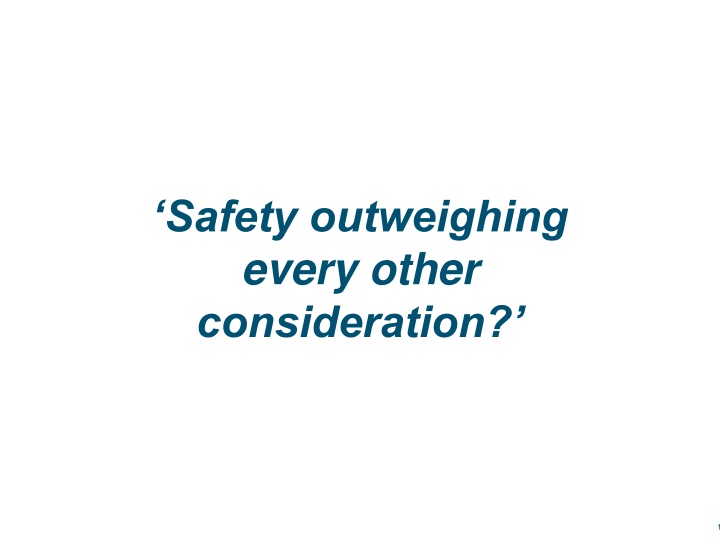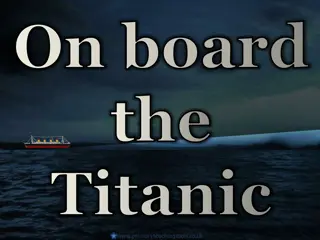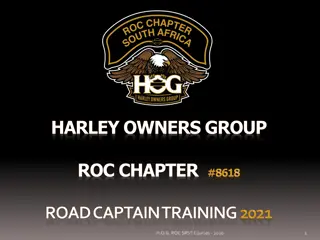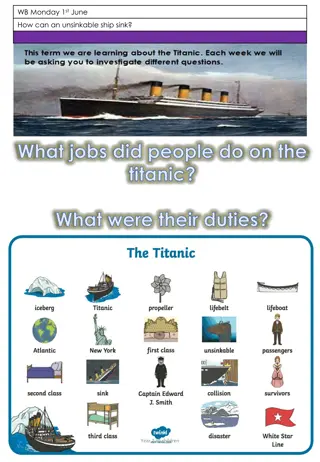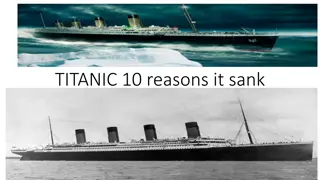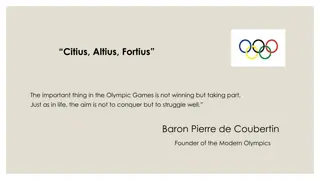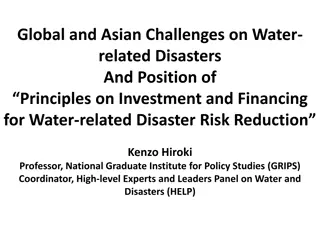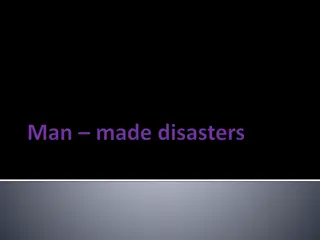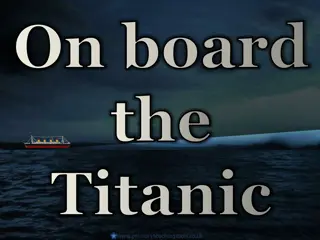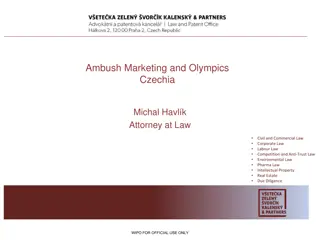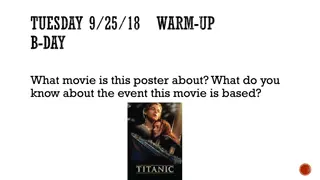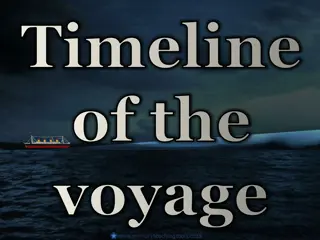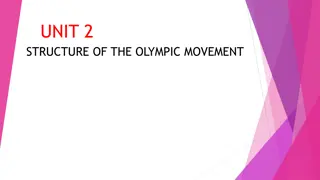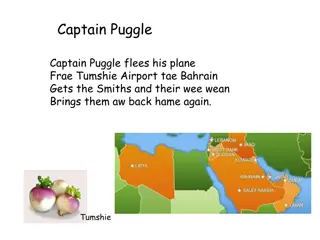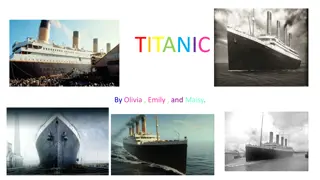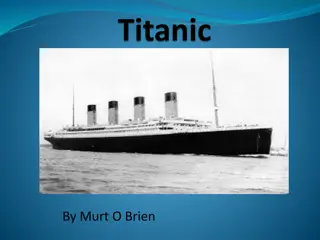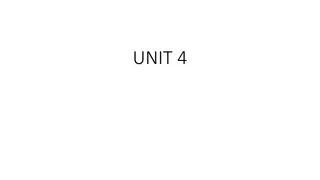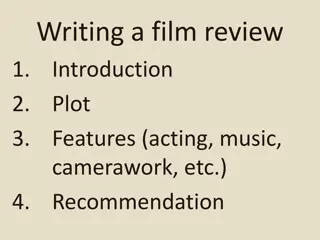The Tragic Tale of the Olympic and Titanic: Safety, Disasters, and Captain Smith
Two sister ships, the Olympic and the Titanic, faced tragic fates due to safety concerns and mishaps. The Olympic endured several accidents before the Titanic's ill-fated voyage. Captain Edward J. Smith's history of incidents raised questions about his leadership. The Titanic's lack of safety measures and mismanagement contributed to the disaster, highlighting the importance of prioritizing safety in maritime operations.
Download Presentation

Please find below an Image/Link to download the presentation.
The content on the website is provided AS IS for your information and personal use only. It may not be sold, licensed, or shared on other websites without obtaining consent from the author.If you encounter any issues during the download, it is possible that the publisher has removed the file from their server.
You are allowed to download the files provided on this website for personal or commercial use, subject to the condition that they are used lawfully. All files are the property of their respective owners.
The content on the website is provided AS IS for your information and personal use only. It may not be sold, licensed, or shared on other websites without obtaining consent from the author.
E N D
Presentation Transcript
Safety outweighing Safety outweighing every other consideration? every other consideration? 1
Recognise this Ship? White Star s The Olympic
Two sister ships The Olympic: Commissioned 14th June 1911 The Titanic: Commissioned 11th April 1912
Olympic Class of White Star Steamers Developed by JP Morgan s White Star shipping group Constructed by Harland & Wolff in Belfast included The Olympic, The Titanic and The Britannic Designed to compete with Cunard & German Shippers on the prestigious transatlantic crossing in the early 1900s Built for affluent travelers offering high-speed luxury Reference: The Riddle of the Titanic , Gardiner et. al. Orion, 1998
The Olympic Prelude to Disaster Damage to the Olympic from the HMAS Hawke impact 21st Jun 1911 Upon commissioning crashed into & almost sunk O.L. Halenbeck in Manhattan 20th Sep 1911 Crashed into the Naval Cruiser the HMS Hawke in Southampton 24th Feb 1912 Knocked off one of its twenty-six tone propellers on a well-known wreck in the Grand Banks Reference: The Riddle of the Titanic , Gardiner et. al. Orion, 1998 Captained by Edward J. Smith. 5
Captain Edward J. Smith 27th Jan 1889: Ran The Republic aground in New York 1st Dec 1890: Ran The Coptic aground in Rio de Janeiro 4th Nov 1909: Ran The Adriatic aground outside New York History of running ships too fast through narrow passages and of not adequately training his officers Reference: The Riddle of the Titanic , Gardiner et. al. Orion, 1998 Captain Smith was commissioned to command the Titanic
Titanic - Tragic Circumstances 14th April 1912 Safety Response Capability Lifeboats on the ship had been reduced from sixty-four boats to twenty-two in lieu of more expansive promenades Smith received at least six warnings of Ice field from ships at dead stop in the area The officers on board The Titanic had not trained with the lifeboats and were unsure of their holding capacity No binoculars in the crow s nest meant that early warning was near impossible There was not a standing safety-response plan.. the Women and Children first response was a reaction more than a previously-agreed plan Titanic sped toward ice field at 22.5 knots vs a recommended 10 knots in such conditions Motivations for this speed Desire to break the transatlantic speed record as encouraged by J. Bruce Ismay MD of White Star who was on board for the maiden voyage Reference: The Riddle of the Titanic , Gardiner et. al. Orion, 1998 7
The Results Lives Saved: 705 Total passengers: 2205 Lives Lost: 1500 Max Lifeboat Capacity: 1600 It wasn t until 45 minutes after the collision that officers commenced preparing the lifeboats Twenty lifeboats were launched Officers feared that the ship s winches would not hold the weight of the recommended 70 people All but the last few lifeboats floated were half-filled It is a fact that had the Officers filled the lifeboats per their specification an additional 600+ people could have been saved Reference: The Riddle of the Titanic , Gardiner et. al. Orion, 1998 8
Safety outweighing Safety outweighing every other consideration? every other consideration? Was the framed notice in the chart room of every White Star liner in 1912 9
Could it have been prevented? Consequences Controls Active Procedural Passive Barriers Design and Construction Asset Operation/ Early Warning Systems Asset Operation/ Safe Operating Limits Leadership Behaviours People & Competencies Design & Construction People & Competencies Emergency Response . . .. Check that employees in safety-critical roles are competent to do the job Executive Rules Examples of Do not set conflicting targets Display visible commitment to Safety Construct all equipment with inherently safer design principles Conduct regular checks to check early warning systems are functional Define and stick to safe operating limits HAZARD REALIZATION Ship hits iceberg 1500 Fatalities HAZARD Ship on High Ocean Damage to bulkhead Ship sinks There was no emergency response/ standing safety plan in place No binoculars in crows nest Desire to break the transatlantic speed record encouraged by the White Star MD Design didn t take into account damage beyond front watertight bulkhead Max lifeboat capacity was far less than total number of passengers on board Captain J Smith had a history of running ships too fast through narrow passages Breaks in Barriers Titanic sped toward ice field at 22.5 knots vs a recommended 10 knots Officers had not trained with the lifeboats and were unsure of their holding capacity Most incidents happen as a result of several barriers failing: processes not in place or not followed, accountabilities not clear, lack of competencies and/or assurance 10
